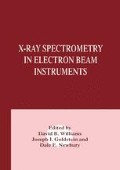Abstract
Labar has shown that relative x-ray line intensities within an x-ray family are important for both qualitative and quantitative microprobe analysis(1). However, the measurement of many of these relative intensities is difficult due to peak overlaps. X rays generated in solid materials by the electron beam in an electron probe microanalyzer may be measured either by an energy dispersive spectrometer or by a wavelength dispersive spectrometer. Although the EDS spectrum can contain all of the x-ray energies from zero to the energy of the electron beam, only a relatively small number of channels in the spectrum may be from the particular characteristic x-ray line of interest. The detector electronics broaden the line into a Gaussian-shaped peak whose width is so broad that in many cases it will overlap other x-ray peaks from the same element or other elements in the specimen. A WDS uses a diffracting crystal to separate the x rays by wavelength according to Bragg’s Law:
where n is the order of the diffraction, X, is the x-ray wavelength, d is the crystal spacing and θ is the diffraction angle. The WDS, therefore, measures only one wavelength at a time (actually, because of crystal imperfections, a narrow band of wavelengths, approximately 10 eV in width for a LiF crystal) and must be mechanically scanned as a function of θ to obtain a spectrum of the x-ray line of interest. Since all of the WDS measurements are from the peak of interest, no time is wasted measuring x rays outside of the peak, and a significantly larger number of x rays are counted than with the EDS. In addition, because the pulse width for WDS is less than 1.ts, as compared to 10–50.ts for EDS, the electron beam current may be increased to obtain an even higher count with the WDS. At high beam currents, the EDS system dead time becomes so high that the EDS may shut off entirely. There are, therefore, two principal benefits of using a WDS for measuring x-ray peaks: first, the superior peak resolution for separating overlapped peaks, and second, the much higher number of x rays counted in the peak of interest. This double benefit should significantly increase the statistical accuracy of the measurements as was demonstrated by Fiori.(2)
Access this chapter
Tax calculation will be finalised at checkout
Purchases are for personal use only
Preview
Unable to display preview. Download preview PDF.
References
J. L. Lábár, C. E. Fiori, and R. L. Myklebust, Microbeam Anal., 2, 169 (1993).
C. E. Fiori and C. R. Swyt, in: Proceedings of the 50th Annual Meeting of the Electron Microscopy Society of America (G. W. Bailey, J. Bentley, and J. A. Small, eds.) p. 1636 (1992).
C. E. Fiori, R. L. Myklebust, and K. Gorlen, NBS Special Publication 604, National Bureau of Standards, Washington, D.C., p. 233 (1981).
G. Remond, Ph. Coutures, G. Gilles, and D. Massiot, Scanning Microsc. 3,1059 (1989).
N. A. Dyson, X-Rays in Atomic and Nuclear Physics, Cambridge University Press, Cambridge, UK (1990).
E. H. Burhop, The Auger Effect and Other Radiationless Transitions, Cambridge University Press, Cambridge, UK (1952).
F. K. Richtmyer and E. G. Ramber, Phys. Rev. 51, 925 (1937).
R. D. Deslattes, Aust. J. Phys. 39, 845 (1986).
Author information
Authors and Affiliations
Editor information
Editors and Affiliations
Rights and permissions
Copyright information
© 1995 Springer Science+Business Media New York
About this chapter
Cite this chapter
Myklebust, R.L. (1995). Fitting Wavelength Dispersive Spectra with the NIST/NIH DTSA Program. In: Williams, D.B., Goldstein, J.I., Newbury, D.E. (eds) X-Ray Spectrometry in Electron Beam Instruments. Springer, Boston, MA. https://doi.org/10.1007/978-1-4615-1825-9_16
Download citation
DOI: https://doi.org/10.1007/978-1-4615-1825-9_16
Publisher Name: Springer, Boston, MA
Print ISBN: 978-1-4613-5738-4
Online ISBN: 978-1-4615-1825-9
eBook Packages: Springer Book Archive

